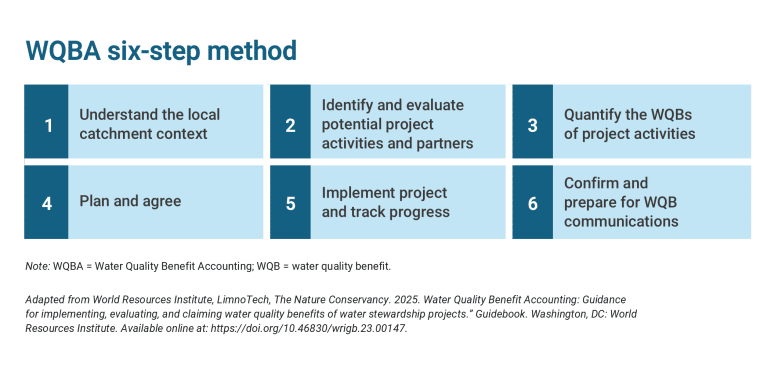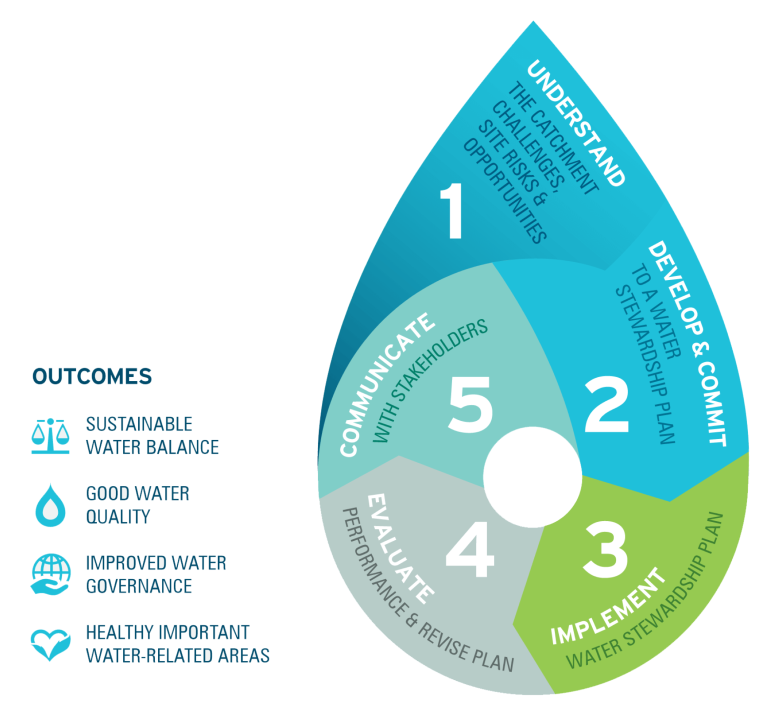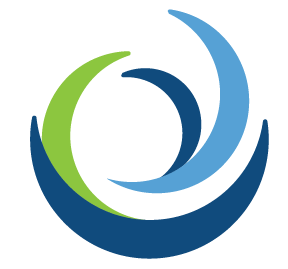
Synergies Between Two Complementary Frameworks: WQBA and AWS
Water Quality Benefit Accounting (WQBA) guidance complements the Alliance for Water Stewardship (AWS) Standard, providing users with a comparable, step-wise method and robust approach for identifying relevant projects and estimating water quality benefits that can be tracked against water quality goals within the framework of a water stewardship plan.
By Ben Roush, Environmental Scientist and Penelope Moskus, Principal and Senior Environmental Scientist (Ann Arbor, MI)
October 23, 2025
For almost two decades, corporations have been setting volumetric water stewardship goals, identifying relevant projects, and quantifying and tracking the volumetric water benefits for those projects. Volumetric Water Benefit Accounting 2.0 (VWBA 2.0) provides a standardized, robust, and flexible methodology for determining volumetric water benefits. In response to the demand for similar guidance on water quality benefit accounting, LimnoTech, along with other stewardship partners, has developed and recently released a Water Quality Benefit Accounting (WQBA) guidebook that provides methods to quantify water quality benefits of water stewardship projects.
WQBA guidance complements the Alliance for Water Stewardship (AWS) Standard, providing users with a comparable, step-wise method and robust approach for identifying relevant projects and estimating water quality benefits that can be tracked against water quality goals within the framework of a water stewardship plan.
There is close alignment between some of the WQBA steps and the AWS Standard steps, as well as the “Good Water Quality Status” outcome. The application of both WQBA and AWS involves determining shared water challenges between the site and across other stakeholders in the basin of interest. Step 1 of WQBA involves understanding the local context and identifying shared water quality challenges. This closely aligns with and can inform Step 1 of the AWS certification process, which requires assessing catchment water quality, site incoming water quality, and site outgoing water quality.

Step 2 of both WQBA and AWS involves planning. Step 2 of the AWS certification process entails developing a water stewardship plan to address site water quality challenges (and how they may be connected to catchment water quality challenges). This plan can include the development of on-site or off-site water stewardship or conservation projects that are often developed in conjunction with local stakeholders and are designed to improve water quality.
These projects could improve water quality in the catchment of interest or result in improved influent or effluent water quality for the site. WQBA Step 2 describes the identification of project activities and partners, outlining eligibility criteria for projects that have the potential to generate water quality benefits, all of which can support AWS Step 2.

Finally, the AWS certification process requires sites to demonstrate the effectiveness of the water stewardship plan using verifiable criteria. Through the development of water quality improvement projects, a site and its stakeholders could apply WQBA methods to estimate improvements and confirm that the desired water quality goals are met.
WQBA provides a standardized approach for calculating water quality benefits by comparing the ‘without-project’ water quality status with the ‘with-project’ water quality status following project implementation, and the results can be verified. The WQBA methodology allows for the estimation of improvements over large geographic areas that may be challenging to monitor. It also provides a standardized method that enables the comparison of results across multiple watersheds and multiple sites.
To summarize, WQBA can be used to inform the application of the AWS Standard, specifically Steps 1 and 2, and results can be used to demonstrate the effectiveness of water quality improvements within the context of a water stewardship plan.
If you would like to learn more about how LimnoTech supports companies with their water stewardship goals and initiatives, including WQBA and AWS, don’t hesitate to get in touch with Penelope Moskus at pmoskus@limno.com or Ben Roush at broush@limno.com.
This article is the tenth in a series of articles authored by LimnoTech staff on water stewardship and AWS. Links to the other water stewardship articles in this series are provided below:
- The Alliance for Water Stewardship Standard – Framing a Decade of Water Stewardship
- Understanding and Engaging Water-Related Stakeholders
- Assessing Water-Related Risk As A Foundation For Stewardship
- Success Strategies for Developing a Site Water Stewardship Plan within the AWS Standard Framework
- Strong Site Teams Lead To Successful Water Stewardship
- Replenish Projects and Volumetric Benefits within the Framework of the AWS Water Stewardship Standard
- Setting the Catchment Context
- Supporting the Implementation of Nature-Based Solutions
- WASH Benefits Accounting Framework
Follow us on LinkedIn and check the Insights & Perspectives page on our website for more information and updates.
Ben Roush joined LimnoTech in April 2022 as an Environmental Scientist. Ben has worked in water resources and environmental sciences for ten years and in environmental consulting since 2019. His primary responsibilities include supporting clients with corporate water stewardship program implementation and volumetric water benefit accounting. Ben has experience working with corporate, non-profit, and government sector clients. His background and expertise include AWS Standard application, volumetric water benefit quantification, water risk assessments, watershed modeling, stakeholder engagement, water footprint analyses, watershed assessments, surface and groundwater monitoring, water quality permit compliance, and soil/groundwater remediation.
Penelope Moskus is a Principal and Senior Environmental Scientist with 30 years of experience. Penelope co-directs LimnoTech’s corporate water stewardship practice area, helping clients develop strategies, guidance, and tools to reduce water-related risks and supporting clients with water stewardship program implementation. She advises clients on project selection, has evaluated volumetric and complementary benefits of hundreds of potential and funded projects, and annually supports corporate reporting for numerous companies. Penelope has supported a major corporation’s replenishment program for 15+ years, including strategy development; development of replenish guidance; quantification and reporting of replenish benefits; validation, verification, assurance, and advising on internal audits. She also supports global and local NGOs, food and beverage companies, energy providers, high-tech companies, agricultural providers, and supermarket chains. Penelope contributed to Volumetric Water Benefit Accounting (VWBA) and is one of the authors contributing to VWBA 2.0. She has piloted Water Quality Benefit Accounting (WQBA) and is a Professionally Credentialed Specialist Consultant for the AWS Standard.
The content herein is the author’s opinion and not published on behalf of the Alliance for Water Stewardship (AWS). The author holds an AWS Professional Credential and this piece of publishing helps fulfil their Continuing Contribution Units requirements. For more information about AWS or the AWS Professional Credentialing Program please visit https://a4ws.org/.




